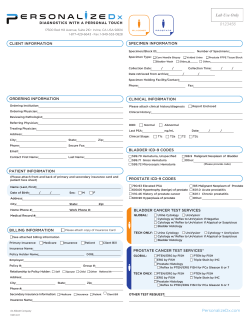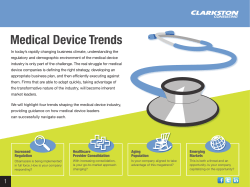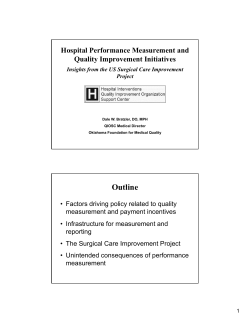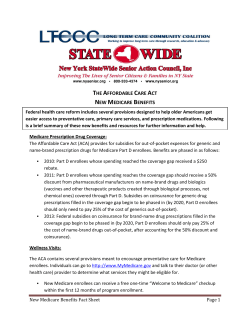
History of CMS Mandatory Reporting Peg Gilbert, RN, MS CIMRO of Nebraska
History of CMS Mandatory Reporting Peg Gilbert, RN, MS CIMRO of Nebraska Quality Improvement Advisor HAI Project Coordinator This material was prepared by CIMRO of Nebraska, the Medicare Quality Improvement Organization for Nebraska, under contract with the Centers for Medicare & Medicaid Services (CMS), a federal agency of the U.S. Department of Health and Human Services. The contents do not necessarily reflect CMS policy 9SOW-NE-BP-49/1010 Centers for Medicare & Medicaid Services (CMS) 1965 Medicare and Medicaid were enacted as Title XVIII and Title XIX of the Social Security Act, extending health coverage Americans aged 65 or older Low-income children deprived of parental support and their caretaker relatives The blind Individuals with disabilities 1966 Medicare was implemented 19 million individuals enrolled 2008 – 45 million enrolled 1983 An inpatient acute hospital prospective payment system for the Medicare program, based on patients' diagnoses, was adopted to replace cost-based payments Where do Measures Come From? Prioritization of Core Measure Topics High impact disease (cost, morbidity, mortality, QoL) Guidelines that provide best practices that can be measured Gaps in care (opportunities for improvement) National Quality Forum endorsed 20 High-Impact Medicare Conditions AMI Alzheimer’s disease and related disorders Atrial fibrillation Breast cancer Endometrial cancer Glaucoma Hip/pelvic fracture Ischemic heart disease Lung cancer Cataract CHF Chronic kidney disease Colorectal cancer COPD Diabetes Major depression Osteoporosis Prostate cancer Rheumatoid arthritis and Osteoarthritis Stroke/TIA History of Measures: The Role of the Joint Commission 1986 developed six sets of performance measures for all accredited hospitals to collect and transmit these data beginning in 1995. Indicator Measurement System or the IMSystem developed but never happened. ORYX Initiative: 1998 Joint Commission First National Program to measure Hospital Quality. 2001 released the original core measures on November 21, 2001. AHRQ one of the 12 agencies in the Department of Health and Human Services Early 1990s, AHRQ developed a set of quality measures that required only routine hospital administrative data Healthcare Cost and Utilization Project, an ongoing federal-state-private sector collaboration to build uniform databases from administrative hospital-based data HCUP Quality Indicators (33) to take advantage of administrative data based on hospital claims The HCUP Quality Indicators are now referred to as the AHRQ Quality Indicators NOT all have a mandatory reporting requirement Administrative data cannot provide definitive measures of health care quality, they can be used to provide indicators of health care quality that can serve as the starting point for further investigation Who is the National Quality Forum? Private, non-profit, open membership, public benefit corporation whose mission is to improve the American healthcare system to provide safe, timely, compassionate and accountable care using the best current knowledge Established in 1999, voluntary consensus standards setting organization Create a foundation for standardized healthcare performance data collection and reporting Identify a national strategy for healthcare quality improvement. Addresses an equitable mechanism for disparate priorities of healthcare’s many stakeholders Final common pathway for review and approval of performance measures Contracts with DHHS for standards development Over 600 standards National Quality Forum Criteria for Evaluation and Selection of Measures 1. Important. The extent to which a measure reflects a variation in quality and low levels of overall performance and represents a significant burden of disease, suffering, or financial costs. (Must meet this level or stops) 2. Scientifically Acceptable. The extent to which a measure provides consistent and credible results when implemented 3. Useable. The extent to which intended audiences (e.g., consumers, purchasers, providers) can understand the results of a measure and are likely to find it helpful for decision-making 4. Feasible. The extent to which data can be obtained within the normal flow of clinical care and an implementation plan can be achieved Other Players in Measure Development Institute of Medicine Error is Human Crossing the Quality Chasm Institute for Healthcare Improvement (IHI) 5 million Lives Campaign Founder is CMS Administrator (Dr. Don Berwick) Michigan Hospital Association Keystone Center The LeapFrog Group (Patient Safety initiatives support (EHR, CPOE, Intensivists), Rates hospitals by survey) Health Research and Educational Trust (HRET) Allows grants for AHA Healthcare Infection Control Practices Advisory Committee (HICPAC) to CDC. Develops national, evidenced based guidelines to prevent HAIs Many More Types of Reportable Measures (See Handout for list) Core Measures: HF, AMI, Pneumonia, SCIP, HCAPS Readmission and Mortality Measures from Medicare claims data AHRQ Patient Safety Indicators and Inpatient Quality Indicators Structural measures from Databases Healthcare Associated Infections Hospital Acquired Conditions AHRQ Pay for Reporting Measures AHRQ Patient Safety and Inpatient Quality Indicator Measures (10) for 2011 (FY2012 APU) Patient Safety Indicators (PSIs) z z z z z z Death among surgical patients with treatable serious complications Iatrogenic pneumothorax, adult Postoperative wound dehiscence Postoperative Respiratory Failure (New) Postoperative DVT or PE (New) Accidental puncture or laceration Inpatient Quality Indicators (IQIs) z z z z Abdominal aortic aneurysm (AAA) mortality rate (with or without volume) Hip fracture mortality rate Mortality for selected medical conditions (composite) Mortality for selected surgical procedures (composite) Structural measures Database Participation Cardiac Surgery Stroke Care Nursing Sensitive Care NHSN is a type of structural measure Healthcare Associated Infections DHHS Action Plan list of 7 HAI measures as High Priority CLABSI (2011 reporting) SSI (2012 reporting) Part of Hospital Acquired Conditions category Reported through NHSN Scheduled release Hospital Compare, Dec-2011 Hospital Acquired Conditions Mandate in 2007, effective October 2008 High cost, high volume Higher paid DRG when a secondary DX Reasonably prevented with EBP Claims data, present on admission coding 10 current categories 2011 HAC Categories Foreign Object Retained After Surgery Air Embolism Blood Incompatibility) Pressure Ulcer Stages III & IV Falls and Trauma Catheter-Associated Urinary Tract Infection (UTI) Vascular Catheter-Associated Infection Manifestations of Poor Glycemic Control Surgical Site Infections: Bariatric, CABG, Select Ortho* Deep Vein Thrombosis and Pulmonary Embolism following Certain Orthopedic Procedures* *No mandatory report Hospital Inpatient Quality Reporting Program (formerly Reporting Hospital Quality Data for Annual Payment Update (RHQDAPU) Uses Medicare payment as an incentive for hospitals to report on the care they provide all adults, regardless of payer Authorized: 2003 Medicare Modernization Act (MMA) 2004 began Submission 10 measures with 0.4% effect on APU 2007 required to report to Medicare their performance on 21 measures to obtain their full payment update. Effect 2% of APU 2010 Added 10 measures and retiring 1, (42 Total measures) Effect 2% of APU 2011 Total of 45 Measures (APU 2012) 2012 Total of 55 Measures (APU 2013) 2013 Total of 57 Measures (APU 2014) FY2010 - RHQDAPU Results - 3433 IPPS hospitals eligible to participate: 3306 - Received full FY2010 APU 127 - Received with a 2% reduction in the FY2010 APU z 79 - Did not fulfill all requirements z 48 - Chose to not participate Mandatory Reporting Programs Types Pay for Reporting Definition: Data submission required to CMS Core Measures z Mortality and Readmission Measures z Structural measures z Healthcare Associated Infections z Value Based Purchasing Hospital Acquired Conditions Value-based Purchasing Linking payment to quality outcomes under the Medicare Program Premise: Current Program rewards quantity over quality Authorized Deficit Reduction Act of 2005, Report to Congress on implementation in 2007, with plan to implement in FY2009 Relative performance threshold: A level of performance that would qualify a hospital for an incentive payment that is determined by comparing the performance of participating organizations (e.g., 75th percentile of the current year’s performance across all hospitals) Effect on Payment by Performance Begins 2013 z “Base operating DRG payment amount” withholds (only PPS): 2013 – 1% 2014 – 1.25% 2015 – 1.5% 2016 – 1.75% 2017 and beyond – 2% Patient Protection and Affordable Care Act of 2010 Title III: Improving the Quality & Efficiency of Health Care For fiscal year 2013 (VBP), the Secretary shall select measures that cover at least the following 5 conditions: acute myocardial infarction heart failure pneumonia surgeries “healthcare-associated infections, as measured by the prevention metrics and targets established in the HHS Action Plan to Prevent Healthcare-Associated Infections (or any successor plan) of the Department of Health and Human Services.” FY2011 Final IPPS Rule Annual IPPS rule from Medicare that defines healthcare funding Defines Mandatory Reporting for the next year to receive Annual Payment Update Available at www.cms.hhs.gov Structure of Mandatory Reporting Department of HHS Operating Divisions: Administration for Children and Families (ACF) z Administration for Children, Youth and Families (ACYF) Administration on Aging (AoA) Agency for Healthcare Research and Quality (AHRQ) Agency for Toxic Substances and Disease Registry (ATSDR) Centers for Disease Control and Prevention (CDC) Centers for Medicare & Medicaid Services Food and Drug Administration (FDA) Health Resources and Services Administration (HRSA) Indian Health Service (IHS) National Institutes of Health (NIH) z National Cancer Institute (NCI) Office of the Inspector General (OIG) Substance Abuse and Mental Health Services Administration (SAMHSA) New Office of Healthcare Quality Private- Non Profit National Quality Forum The Joint Commission National Integrated Accreditation for Healthcare Organizations Quality Improvement Organizations Validation Previous Process The quarterly validation sample of all in the RHQDAPU program Five randomly-selected episodes of care independently re-abstracted by CDAC, a CMS contractor. Hospitals are eligible to appeal if they fail to accurately abstract 80% of the data elements sampled. Current Process 800 PPS hospitals (random selection) – quarterly sample, pass 75%, Maximum of 12 cases reviewed z Also include all hospitals who fail previous year validation Nebraska hospitals: Nebraska Methodist, St. Elizabeth, Nebraska Orthopedic, Alegent-Immanuel, Creighton HAI will not be included Public Reporting Hospital Compare: www.hospitalcompare.hhs.gov A tool on the CMS Web site that provides information on how well hospitals care for their adult patients with certain medical conditions Nursing home and Home Health available. Quality Check: www.qualitycheck.org The Joint Commission public reporting site Patient Safety goals Accreditation ratings CMS Core measure, HCAPS Healthgrades: www.healthgrades.com Independent Health ratings MD, Hospital, Nursing Homes What’s a QIO got to do with it? 1982 -The Medicare Quality Improvement Organization (QIO) Program was created to improve quality and efficiency of services delivered to Medicare beneficiaries. Early 90’s - Case review was supplemented by the collection of data for quality measures. PROs (renamed Quality Improvement Organizations) offered technical assistance to providers. During this second phase of the program, improvement on quality measures occurred. Data Quality Reporting Role Assist hospitals with specification questions Interpret reporting requirements Meet reporting deadlines Iowa QIO is data warehouse for inpatient measures Florida fulfills the QIO role for data reporting Key Points National performance measures are not made up by CMS. The measures are based on published guidelines with explicit input from specialty societies and practicing physicians The measures are standardized nationally and publicly vetted through open public comment by the National Quality Forum Reporting of the measures is the same for every hospital in the nation Measures can have indirect or direct harm Unintended Consequences Indirect Harm Caregivers shift attention to those conditions that are subject to payment incentives – e.g., triage pneumonia patients in preference to abdominal pain patients Focus on glucose control in a diabetic while ignoring control of hyperlipidemia Risk avoidance – turn away high risk patients Teach to the Test Topped out Measures Direct Harm Administration of multiple or unnecessary antibiotics to pass measures on antibiotic selection “Gaming” measures – e.g., just giving one dose of warfarin within 24 hours of surgery to pass the SCIP measure and otherwise leaving the patient unprotected Documentation of unrealistic contraindications to exclude a patient from the measure Diagnosis change to avoid selection (CHF) Lessons Learned in the Mandatory Reporting Journey Measure development - There is always a clinical scenario that is unusual, doesn’t fit the norm for data abstraction instructions or measure specifications, and which none of us thought of. Virtually impossible to write measure specifications that will address all possible denominator exclusions Will likely be more difficult when writing measure specifications for electronic health records While “perfect” care is desirable even in the best systems, errors occur The measure specifications for many measures address the most common reasons for exclusion, but rarely address every possible clinical scenario While the target rate of performance for most measures may be very high, it is not (and should not be) 100% for some if not most measures Future of Mandatory Reporting Comparative Effectiveness (AHRQ) Joint Commission Accountability Measures Large volume of research proves relationship to improved outcomes Process is closely connected to outcome Measure accurately assesses process No or minimal unintended adverse effects Example: Surgical AB Prophylaxis, Non: HF Discharge instructions Physician Compare Site More HAC: Potential C.Diff, Iatrogenic Pneumothorax Focus on Falls as #1 HAC Electronic abstraction Aligning with ‘Meaningful Use’ – CPOE, Allergy list, and Drug Interactions Why are We Doing This? 2003 Hospital Quality Incentive Demonstration™ (HQID), combined project of Premier and CMS* Participating hospitals have raised overall quality an average of 17.2 percent over four years based on delivery of 30-plus nationally standardized and widely accepted care measures to patients in five clinical areas. The improvements have saved the lives of an estimated 4,700 heart attack patients. More than 1.5 million patients treated in five clinical areas at the 230 hospitals also received about 500,000 additional recommended evidence-based clinical quality measures, such as smoking cessation, discharge instructions and pneumococcal vaccination. *From an article by Susan D. DeVore, President and CEO, Premier healthcare alliance, “Results from the First 4 Years of Pay for Performance” in the January 2010 edition of HFM Magazine. Mandatory Reporting States CLABSI number .82 Changes in National Performance Baseline to Q2, 2008 Abx 60 min Guideline Abx 120 100 Data source changed from indepen dently abstract ed to hospital selfcollected 92.6 55.7 96.4 92.7 89.4 Deficit Reduction Act and STS recommendation of antibiotics for up to 48 hours for cardiac surgery 40 40.7 20 Medicare Modernization Act 08 20 08 20 Q 3 Q 2 20 08 07 Q 1 20 07 Q 4 20 07 Q 3 07 Q 2 20 06 20 Q 1 Q 4 20 06 06 Q 3 20 06 20 Q 2 05 Q 1 20 05 Q 4 20 05 20 Q 3 20 Q 2 Q 1 20 05 04 04 Q 4 20 04 20 Q 3 20 20 04 Q 2 03 Q 1 20 03 Q 4 20 03 Q 3 20 03 Q 2 20 02 Q 1 02 Q 4 20 02 Q 3 20 02 20 Q 2 20 20 01 * 0 Q 1 Percent 80 60 Abx discontinued Questions? CIMRO of Nebraska 1230 O Street, Suite 120 Lincoln, Nebraska 68508 P: 402.476.1399 F: 402.476.1335 W: www.cimronebraska.org
© Copyright 2025





















